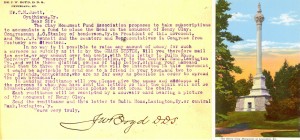Manuscripts Technician Donna Lile came across an unusual piece of undated correspondence while processing the Fennell Papers which document a prominent Cynthiana, Kentucky family. The undated letter’s first sentence is slightly unnerving. It reads: “The Clay Monument Fund Association proposes to take subscriptions to accumulate a fund to place the head on the monument of Henry Clay.”
Henry Clay died in Washington, D.C. on June 29, 1852. A group of his Lexington friends resolved “that a NATIONAL MONUMENT OF COLOSSAL PROPORTIONS” be erected to commemorate “the virtuous deeds of his long and glorious life.” Eleven days later, Clay’s funeral service was conducted in front of his beloved Ashland before 30,000 people. From there, the body was moved with great fanfare and respect to Lexington Cemetery. The monument was completed on July 4, 1861 and featured a large marble statue of Clay carved by William Struthers of Philadelphia atop a 130 foot column. Clay’s remains were not moved inside the monument until his wife’s death in 1864.
On July 21, 1903 a terrible storm hit Lexington and the local paper reported that “not even the sacred effigy of Henry Clay could escape its malignant fury.” After being hit by lightning, the 350-pound sculpted marble head of the Clay staute fell and embedded intself in six inches of earth. The statue remained embarrassingly headless for several years. The Monument Fund Association sent out a “chain system” letter, such as the one found in the Fennell Collection, soliciting funds to replace the head. The letter entreated recipients to “mail ten cents, or any amount over ten cents, with this letter…to the Secretary and Treasurer…and write three distinct copies of this letter, signing your name and send them to three of your friends who will be interested in this movement.” Their efforts were largely unsuccessful, and the head was not replaced until the General Assembly appropriated $10,000 for the work.
Sculptor Charles J. Mulligan of Chicago was commissioned to replace the older Clay statue with a sturdier specimen. The new statue was hoisted into place in May 1910. Only a few months later, lightning again hit the Clay statue causing considerable damage. The General Assembly came to the rescue with $10,000 for repairs. The Mulligan piece was restored most recently in 1975, and rededication speeches were made on July 29, 1976. To see the Fennell Family finding aid click here.

